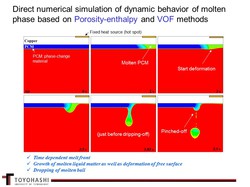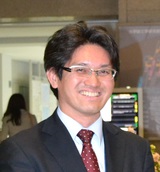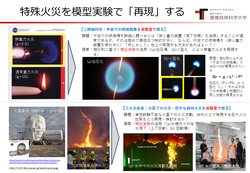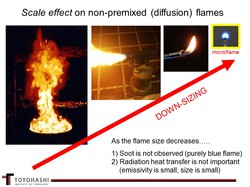
Nakamura, Yuji
| Affiliation | Department of Mechanical Engineering |
|---|---|
| Concurrent post | Research Center for Collaborative Area Risk Management (CARM) |
| Title | Professor |
| Fields of Research | Combustion, Fire Dynamics, Scale Modeling, Space Engineering, Safety Engineering |
| Degree | Dr. Eng. |
| Academic Societies | Combustion Society of Japan, Japan Association for Fire Science and Engineering, The Japan Society of Experimental Mechanics, Japan Society of Microgravity Application, The Japan Society of Mechanical Engineers |
| yuji@me Please append ".tut.ac.jp" to the end of the address above. |
|
| Laboratory website URL | https://ece.me.tut.ac.jp/wp/ |
| Researcher information URL(researchmap) | Researcher information |
Research
Scale modeling of combustion, Study in "micro-scale" combustion, Fire-safety strategy in extra-ordinal environments (cable fire in nuclear power plant, fires in space habitant etc)
Theme1:Scale modeling of combustion
Overview
Scale modeling is classical yet effective concept/approach to understand the phenomena with real scale (prototype) via ones with lab scale (scale model). This is even worthwhile when the prototype is very hard to access; likely extra-ordinal conditions. Fire is a kind of typical problem which is suitable for the scale modeling approach. Furthermore, fire in space is more likely excellent application to employ this approach to know its fundamentals and fire-safety strategy under such extra-ordinal environment.
We have successfully made the applicability of scale modeling in order to represent flames in space (i.e., under microgravity environment); see Fig.A. This fact ensures that scale modeling concept works well to study flames in extra-ordinal condition, which is generally very hard to access.
Selected publications and works
【awards】
ISCM Young Investigator Award, ISCM, 2009.9
Young Researcher Encouragement Award, Combustion Society of Japan, 2008.12
Young Researcher Encouragement Award, Japan Society of Microgravity Application, 2008.11
Keywords
Theme2:Micro-scale combustion
Overview
When the diffusion flame is large, it becomes heavily sooty and strongly fluctuated subjected to the buoyancy. As the scale decreases, surprisingly, such characters becomes totally opposite. Namely, the flame becomes blue (non-sooty) and very stiff with semi-spherical shape. It looks that this flame does not feel any buoyancy effect on its shape. This is what we call "microflame".
As the flame approaches to the microflame regime, the thermal interaction between burner and the flame becomes significant and burner tip is abnormally heated up. Then it assists the flame stability so that only little fuel is necessary to support the flame over the burner. In this way, microflame is possibly useful to study/examine/elucidate the minimum scale of the flame.
Selected publications and works
【awards】
Editage Award (insentive award), Leave-a-nest, 2012.8
Technology Award, The Japan Society for Precision Engineering (Hokkaido Branch), 2009.9
Technology Award, The Japan Society for Precision Engineering (Hokkaido Branch), 2008.9
Technology Award, The Japan Society for Precision Engineering (Hokkaido Branch), 2007.8
【invited talks (selected)】
Invited Talk,Concept of Self-sustained Micro-combustion: Do we have "flames" in micro-scale?", The 7th Nagoya University-UCLA International Symposium (Hokkaido University and Nagoya University Global COE Joint Symposium), 2012.9
Invited Talk, "Structure and Unique Featurs in Microflame", Research Committee -Microflame Array-, Aichi Science and Technology Foundation, 2012.8
Invited Speaker, "Microflame; As a Model of Droplet/Spray Combustion", ICFD2010 (Grobal COE, Tohoku University), 2010.11
Keywords
Theme3:Fire-safety strategy in extra-ordinal environments (fires in NPP/space habitants etc)
Overview
 Fig.C Example of direct numerical simulation to track the dynamic behavior of melting and falling off the molten polymer from the top of the numerical domain
Fig.C Example of direct numerical simulation to track the dynamic behavior of melting and falling off the molten polymer from the top of the numerical domainElectric cable is one of the major factor to lead the fire in extra-ordinal environment, likely nuclear power plant (NPP) and space habitants. When the combustion mode can be simplified, above-mentioned scale modeling concept can immediately work to reproduce the phenomena in a handy way, however, in some special condition, it is hard to be simplified since the complex multi-phases, multi-(chemico)physics processes are equally involved. Burning electric cable is actually such typical example. Once the cable burns, wire-coating (made of polymer) would melt and eventually fall-off from the firing zone. Since the molten polymer can continuously burns after the drop, resulting in pool fire would form there. This means that firing zone is enlarged in discrete manner so that fire damage will grow dramatically.
We have successfully done to develop the numerical model to handle such complex dynamic behavior (melting and subsequent falling-off). Now the model is going to be upgraded to include the gasification and chemical reaction (flaming) in gas-phase. This allows us to predict the precise physical processes on fire in extra-ordinal environment and enable us to consider the appropriate fire-safety management. In addition to such simulation, we do various experiments (e.g., fire initiated by arc discharge, development of novel fire extinguisher in space habitants).
Selected publications and works
【awards】
Excellent Paper Award, Fire and Disaster Management Agency (FDMA) of Ministry of Internal Affairs and Communications, 2011.10
Excellent Poster Award (International Mohri Poster Award), The 8th Japan-China-Korea Workshop Microgravity Sciences for Asian Microgravity Pre-Symposium, (as supervisor) 2010.9
【Others】
Invited Talk, Worcester Polytechnic Institute (Department of Fire Protection Engineering), Invited Seminar (USA) (2010.11) "Electric Cable Fires: Ongoing Research on Small-Scale Flame Spread Tests
Keywords
Title of class
Advanced Energy Engineering (graduate course), Advance in Combustion (graduate course), Combustion Engineering (B4), Computer-aided Engineering (B3), Applied Thermal Engineering (B3)
Others (Awards, Committees, Board members)
【Board members】
Progress in Scale Modeling, Editorial Board (Combustion Section)(2007.6)
6th International Symposium on Scale Modeling (ISSM-6), Hawaii, Chair(2009.9)
Fire Technology, Editorial Board (2013.8-)
Progress in Scale Modeling Vol.2, Associate Editor(2013.9)
Fire Technology, Associate Editor (2014.2-)
Advanced Fossil Fuel Technologies (Frontiers in Energy Research), Editorial Board (2014.10-)
The Japan Society of Microgravity Application, Board of Trustees (2014.4-)
【Awards (selected)】
JSME Research Encouragement Award, Japan Society of Mechanical Engineers, 2002.4
Outstanding Paper Award, Japan Institute of Energy, 2008.8
Young Researcher Encouragement Award, Japan Society of Microgravity Application, 2008.11
Young Researcher Encouragement Award, Combustion Society of Japan, 2008.12
ISCM Young Investigator Award, ISCM, 2009.9
Excellent Paper Award, Fire and Disaster Management Agency (FDMA) of Ministry of Internal Affairs and Communications, 2011.10
Steel Techninology Award, Steel Foundation for Environmental Protection Technology, 2012.6
Editage Award (insentive award), Leave-a-nest, 2012.8
【invited lecture(s)/talk(s) (selected)】
Purdue University, Prof. J. Gore's Laboratory at School of Engineering, Invited Seminar (USA)(2001.7)"Enclosure Effect on Flame Spread over Solid Fuels in Microgravity"
Building Fire Research Lab, The National Institute of Standards and Technology, Invited Seminar (USA)(2008.8) "Fundamental Aspects of Acetone-OH Simultaneous PLIF Technique: Application to Diagnostics of Ultra-Lean Combustion"
ICFD2010 (GCOE, Tohoku Univ.) Invited Speaker, Sendai (2010.11) "Microflame; As a Model of Droplet/Spray Combustion"
Worcester Polytechnic Institute (Department of Fire Protection Engineering), Invited Seminar (USA) (2010.11) "Electric Cable Fires: Ongoing Research on Small-Scale Flame Spread Tests"
The 7th Nagoya University-UCLA International Symposium (Hokkaido University and Nagoya University Global COE Joint Symposium), Invited Speaker, Sapporo (2012.9), "Concept of Self-sustained Micro-combustion: Do we have "flames" in micro-scale?"
ICFD2014 Invited Speaker, Sendai (2014.10) "Behavior of the Polymeric Material subjected to the Fire: Direct Numerical Simulation of Melting and Deforming Processes of Degrading Polymeric Material"
University of Maryland, Collage Park (Department of Fire Protection Engineering), Invited Talk (USA) (2015.3) "Scale modeling of flames: from microgravity to micro-flames"
Invited Speaker, "How Well We Can Predict the Occurance of Large Fire Whirl through Scale Model Experiment?", ICFD2015, Sendai 2015.10
Invited Lecturer, "Excess-enthalpy Combustion via a Miniaturization of Jet Flames", JSME, Research Committee for Innovative Engine Development, Nagoya 2016.1
Invited Speaker, "Combustion Modeling of Melting/Burning Thermoplastic Material", ICFD2016, Sendai 2016.10
【acquired research grants (selected)】
Nakamura, Y., "Study on Semi-Spherical Flame in Earth Gravity", Grant-in-Aid for Scientific Research, The Ministry of Education, Science, Sports and Culture, 1999.4-2000.3, 1.3 million JPY
Nakamura, Y., "Fire Safety in Electric Circuit", Grant-in-Aid for Young Scientists (B), The Ministry of Education, Science, Sports and Culture, 2005.4-2007.3, 3.6 million JPY
Nakamura, Y., and Ito, H.,"Fire Hazard Study in Enclosed Depressurized Environment", Japan Space Forum -Exploratory Research for Space Utilization-, 2006.12-2008.9, 2.86 million JPY
Nakamura, Y., "Fundamental Study of Irradiated Ignition of Solid in Low Pressure Environment", Grant-in-Aid for Young Scientists (B), The Ministry of Education, Science, Sports and Culture, 2007.4-2009.3, 3.4 million JPY
Nakamura, Y., and Hirota, M., "Development of New Diagnostics Scheme for Ultra-Lean Combustion via Acetone-OH Simultaneous PLIF Method", TEPCO Research Foundation (Fundamental Research Grant), 2008.4-2010.3, 10.0 million JPY
Nakamura, Y., "Theoretical Study and Validartion of Flame Spread of Electric Wire: What is Key Factor to Cause Steady/Non-steady Spread Behavior?", Grant-in-Aid for Young Scientists (A), The Ministry of Education, Science, Sports and Culture, 2009.4-2012.3, 25.9 million JPY
Nakamura, Y., "Formation of Extreme High-temperature Combustion by using Crossed-flame Concept; Its Use for Exploration of Non-equilibrium Combustion Physics", Grant-in-Aid for Challenging Exploratory Research, The Ministry of Education, Science, Sports and Culture, 2009.4-2011.3, 3.2 million JPY
Nakamura, Y., "Development of Mathematical Model for Fire of Electric Facilities for Safety Management of Nuclear Plant", yr2009-2010 Contracted Research, Japan Nuclear Energy Safety Organization (JNES), 2009.4-2011.3, 24.0 million JPY
Nakamura, Y., "Development of Mathematical Model for Fire of Electric Facilities for Safety Management of Nuclear Plant", yr2011 Contracted Research, Japan Nuclear Energy Safety Organization (JNES), 2011.8-2012.2, 17.1 million JPY
Nakamura, Y., "Development of Mathematical Model for Fire of Electric Facilities for Safety Management of Nuclear Plant", yr2012-2013 Contracted Research, Japan Nuclear Energy Safety Organization (JNES), 2012.8-2014.2, 28.0 million JPY
Nakamura, Y., and Wakatsuki, K., "Fundamental Research on Establishing Novel Extinguishment Methodology for Magnesium Fire", Grant-in-Aid for Challenging Exploratory Research, The Ministry of Education, Science, Sports and Culture, 2013.4-2015.3, 3.64 million JPY
JAXA-AO, 3rd JEM Utilization Project: FLARE, Co-Onvestigator (Leader of Gr.4), 2013.4-2018.3, total: 32.0 million JPY
Nakamura, Y., "Super-stabilized Concept in Miniaturization of Jet Flame: Excess-enthalpy Combustion via Heat Recirculation inside the Burner", Grant-in-Aid for Scientific Research, The Ministry of Education, Science, Sports and Culture, 2014.4-2017.3, 15.31 million JPY
Nakamura, Y., Sekimoto, K., and Kuwana, K., "Wildland Fire Whirl Experiment", JKA supported research topic, 2014.4-2016.3, 6.0 million JPY
Nakamura, Y., "Combustion Modeling of Electric Facility subjected to Fire", Nuclear Regulation Authority in Japan , 2014.12-2015.3, 7.3 million JPY
Nakamura, Y., and Kuwana, K., "Science in Fire Whirl: Vortex Structure and Its Stability Analysis", Grant-in-Aid for Challenging Exploratory Research, The Ministry of Education, Science, Sports and Culture, 2015.4-2017.3, 3.77 million JPY
Nakamura, Y., "Combustion Modeling of Electric Facility subjected to Fire", Nuclear Regulation Authority in Japan , 2015.11-2016.3, 14.98 million JPY
Nakamura, Y., "Excess-enthapy Combustion via Miniaturization of Jet Burner: A Unique Stability Mechanism of Micro-jet Flames", Fund for the Promotion of Joint International Research (Fostering Joint International Research), The Ministry of Education, Science, Sports and Culture, 2017.4-2019.3 (planned), 10.60 million JPY
Nakamura, Y., Matsuoka T., and Hosogai, A., "Modeling of Combustion with Melting/dripping Dunamics of Polymer ", Grant-in-Aid for Scientific Research (Kiban-B), The Ministry of Education, Science, Sports and Culture, 2017.4-2019.3, 17.94 million JPY



